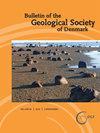Wireline log stratigraphy of the lower Cambrian Læså Formation, Bornholm, Denmark.
IF 1
4区 地球科学
Q2 Earth and Planetary Sciences
引用次数: 0
Abstract
A detailed correlation of the lower Cambrian Læså Formation on southern Bornholm, Denmark, is based on gamma ray and formation resistivity wireline logs from 25 water supply wells and 5 scientific boreholes. The interpretation hinges on comparison with the wireline log suite obtained in the fully cored Borggård-1 borehole that penetrated the formation in its entirety. The Norretorp Member, 102.9 m thick in Borggård-1, consists predominantly of intensively bioturbated siltstone. Several levels are strongly glauconitic and usually also contain phosphorite nodules. Fine-grained sandstone beds, 0.5–20 cm thick and interpreted as tempestites, occur throughout the unit; a few thicker sandstone layers consist of stacked tempestites. However, many sandstone beds, primarily in the upper 2/3 of the member, have been partly or totally obliterated by the pervasive bioturbation. The overlying Rispebjerg Member, 3.5 m thick in Borggård-1, is dominated by well-cemented medium to coarse-grained quartz sandstone. The variable lithology of the Læså Formation is illustrated by photos of core samples from Borggård-1. The studied wells are located on different fault blocks with 18 km between the easternmost and westernmost well sites. The Norretorp Member is of almost similar thickness throughout the study area whereas the Rispebjerg Member is 2.2–5.6 m thick. The essentially unchanging thickness of the Læså Formation and the sheet like distribution of tempestites demonstrate that the intense faulting of southern Bornholm post-dates deposition. The Norretorp Member is divided into a lower log-unit (57 m thick in Borggård-1) characterized by a moderately variable gamma ray log pattern and an upper log-unit (46 m thick in Borggård-1) exhibiting a more uniform gamma radiation of overall lower intensity. The log-units reflect a more common occurrence of glauconite and phosphorite in the lower part of the member and a higher sand content in the upper part. These lithological differences are also reflected by a generally higher resistivity and P-wave velocity in the upper log-unit. Seven thicker sandstone horizons (15–80 cm thick), labelled S1 to S7, are laterally persistent within the Norretorp Member. Four additional horizons, referred to as MGL [multiple gamma low], MGH [multiple gamma high], MM [middle marker] and GH [gamma high], are also laterally widespread. A readily identifiable red-brown horizon is located at 4.4–5.9 m above the base of the Læså Formation in Borggård-1: it appears to be developed throughout the study area.丹麦博恩霍尔姆岛下寒武统 Læså 地层的钢丝绳测井地层学。
对丹麦博恩霍尔姆岛(Bornholm)南部下寒武统 Læså 地层的详细相关性研究,是根据 25 口供水井和 5 个科研钻孔的伽马射线和地层电阻率线性测井资料进行的。解释的关键在于与完整穿透该地层的 Borggård-1 号钻孔中获得的线性测井资料进行比较。Norretorp 构造在 Borggård-1 中的厚度为 102.9 米,主要由密集生物扰动的粉砂岩组成。有几层具有强烈的釉质,通常还含有磷酸盐结核。整个单元中都有 0.5-20 厘米厚的细粒砂岩层,被解释为风化岩;少数较厚的砂岩层由堆叠的风化岩组成。不过,许多砂岩层(主要位于该岩层的上 2/3 部分)已被普遍的生物扰动部分或完全湮没。上覆的 Rispebjerg 组(在 Borggård-1 岩石中厚度为 3.5 米)以胶结良好的中粗粒石英砂岩为主。Borggård-1 号井的岩心样本照片说明了 Læså 组岩性的多变性。所研究的油井位于不同的断层块上,最东端和最西端的井址之间相距 18 公里。在整个研究区域内,Norretorp 组层的厚度几乎相似,而 Rispebjerg 组层的厚度为 2.2-5.6 米。Læså Formation 的厚度基本不变,而且 tempestites 呈片状分布,这表明博恩霍尔姆岛南部强烈的断层沉积是在沉积之后发生的。Norretorp 组分为下部测井单元(Borggård-1 号地层厚 57 米)和上部测井单元(Borggård-1 号地层厚 46 米),下部测井单元和上部测井单元的伽马射线辐射较为均匀,强度较低。这些测井单元反映出该岩层下部更常见的是青云岩和磷钇矿,而上部的砂含量较高。上部测井单元的电阻率和 P 波速度普遍较高,也反映了这些岩性差异。诺雷托普岩层中横向存在七个较厚的砂岩层(厚 15-80 厘米),标号为 S1 至 S7。另外四个地层(分别为 MGL[多伽马低值]、MGH[多伽马高值]、MM[中值]和 GH[伽马高值])也在横向广泛分布。一个易于识别的红褐色地层位于 Borggård-1 中 Læså 地层底部以上 4.4-5.9 米处:似乎在整个研究区域都有发育。
本文章由计算机程序翻译,如有差异,请以英文原文为准。
求助全文
约1分钟内获得全文
求助全文
来源期刊

Bulletin of the Geological Society of Denmark
GEOSCIENCES, MULTIDISCIPLINARY-
CiteScore
2.80
自引率
16.70%
发文量
28
审稿时长
>12 weeks
期刊介绍:
The Bulletin publishes contributions of international interest in all fields of geological sciences on results of new work on material from Denmark, the Faroes and Greenland. Contributions based on other material may also be submitted to the Bulletin if the subject is of relevance for the geology of the area of primary interest.
 求助内容:
求助内容: 应助结果提醒方式:
应助结果提醒方式:


